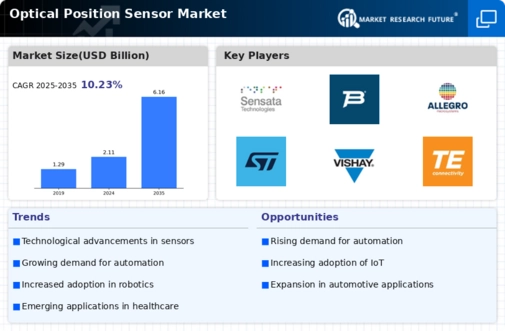Linear Position Sensors
Rotary Position Sensors
Non-Contact Type
Contact Type
Digital Output
Analog Output
Optical position sensor Market By Application Outlook (USD Billion, 2018-2032)
Machine Tools
Robotics
Motion Systems
Material Handling
Test Equipment
Others (Inspection Systems and Measurement)
Optical position sensor Market By End-User Outlook (USD Billion, 2018-2032)
Manufacturing
Automative
Aerospace
Packaging
Healthcare
Electronics
Others (Power and Mining Industries)
Linear Position Sensors
Rotary Position Sensors
Non-Contact Type
Contact Type
Digital Output
Analog Output
Machine Tools
Robotics
Motion Systems
Material Handling
Test Equipment
Others (Inspection Systems and Measurement)
Manufacturing
Automative
Aerospace
Packaging
Healthcare
Electronics
Others (Power and Mining Industries)
Linear Position Sensors
Rotary Position Sensors
Non-Contact Type
Contact Type
Digital Output
Analog Output
Machine Tools
Robotics
Motion Systems
Material Handling
Test Equipment
Others (Inspection Systems and Measurement)
Manufacturing
Automative
Aerospace
Packaging
Healthcare
Electronics
Others (Power and Mining Industries)
Linear Position Sensors
Rotary Position Sensors
Non-Contact Type
Contact Type
Digital Output
Analog Output
Machine Tools
Robotics
Motion Systems
Material Handling
Test Equipment
Others (Inspection Systems and Measurement)
Manufacturing
Automative
Aerospace
Packaging
Healthcare
Electronics
Others (Power and Mining Industries)
Linear Position Sensors
Rotary Position Sensors
Non-Contact Type
Contact Type
Digital Output
Analog Output
Machine Tools
Robotics
Motion Systems
Material Handling
Test Equipment
Others (Inspection Systems and Measurement)
Manufacturing
Automative
Aerospace
Packaging
Healthcare
Electronics
Others (Power and Mining Industries)
Germany Outlook (USD Billion, 2018-2032)
Linear Position Sensors
Rotary Position Sensors
Non-Contact Type
Contact Type
Digital Output
Analog Output
Machine Tools
Robotics
Motion Systems
Material Handling
Test Equipment
Others (Inspection Systems and Measurement)
Manufacturing
Automative
Aerospace
Packaging
Healthcare
Electronics
Others (Power and Mining Industries)
Linear Position Sensors
Rotary Position Sensors
Non-Contact Type
Contact Type
Digital Output
Analog Output
Machine Tools
Robotics
Motion Systems
Material Handling
Test Equipment
Others (Inspection Systems and Measurement)
Manufacturing
Automative
Aerospace
Packaging
Healthcare
Electronics
Others (Power and Mining Industries)
Linear Position Sensors
Rotary Position Sensors
Non-Contact Type
Contact Type
Digital Output
Analog Output
Machine Tools
Robotics
Motion Systems
Material Handling
Test Equipment
Others (Inspection Systems and Measurement)
Manufacturing
Automative
Aerospace
Packaging
Healthcare
Electronics
Others (Power and Mining Industries)
Linear Position Sensors
Rotary Position Sensors
Non-Contact Type
Contact Type
Digital Output
Analog Output
Machine Tools
Robotics
Motion Systems
Material Handling
Test Equipment
Others (Inspection Systems and Measurement)
Manufacturing
Automative
Aerospace
Packaging
Healthcare
Electronics
Others (Power and Mining Industries)
Linear Position Sensors
Rotary Position Sensors
Non-Contact Type
Contact Type
Digital Output
Analog Output
Machine Tools
Robotics
Motion Systems
Material Handling
Test Equipment
Others (Inspection Systems and Measurement)
Manufacturing
Automative
Aerospace
Packaging
Healthcare
Electronics
Others (Power and Mining Industries)
Linear Position Sensors
Rotary Position Sensors
Non-Contact Type
Contact Type
Digital Output
Analog Output
Machine Tools
Robotics
Motion Systems
Material Handling
Test Equipment
Others (Inspection Systems and Measurement)
Manufacturing
Automative
Aerospace
Packaging
Healthcare
Electronics
Others (Power and Mining Industries)
Linear Position Sensors
Rotary Position Sensors
Non-Contact Type
Contact Type
Digital Output
Analog Output
Machine Tools
Robotics
Motion Systems
Material Handling
Test Equipment
Others (Inspection Systems and Measurement)
Manufacturing
Automative
Aerospace
Packaging
Healthcare
Electronics
Others (Power and Mining Industries)
Linear Position Sensors
Rotary Position Sensors
Non-Contact Type
Contact Type
Digital Output
Analog Output
Machine Tools
Robotics
Motion Systems
Material Handling
Test Equipment
Others (Inspection Systems and Measurement)
Manufacturing
Automative
Aerospace
Packaging
Healthcare
Electronics
Others (Power and Mining Industries)
Linear Position Sensors
Rotary Position Sensors
Non-Contact Type
Contact Type
Digital Output
Analog Output
Machine Tools
Robotics
Motion Systems
Material Handling
Test Equipment
Others (Inspection Systems and Measurement)
Manufacturing
Automative
Aerospace
Packaging
Healthcare
Electronics
Others (Power and Mining Industries)
Linear Position Sensors
Rotary Position Sensors
Non-Contact Type
Contact Type
Digital Output
Analog Output
Machine Tools
Robotics
Motion Systems
Material Handling
Test Equipment
Others (Inspection Systems and Measurement)
Manufacturing
Automative
Aerospace
Packaging
Healthcare
Electronics
Others (Power and Mining Industries)
Linear Position Sensors
Rotary Position Sensors
Non-Contact Type
Contact Type
Digital Output
Analog Output
Machine Tools
Robotics
Motion Systems
Material Handling
Test Equipment
Others (Inspection Systems and Measurement)
Manufacturing
Automative
Aerospace
Packaging
Healthcare
Electronics
Others (Power and Mining Industries)
Linear Position Sensors
Rotary Position Sensors
Non-Contact Type
Contact Type
Digital Output
Analog Output
Machine Tools
Robotics
Motion Systems
Material Handling
Test Equipment
Others (Inspection Systems and Measurement)
Manufacturing
Automative
Aerospace
Packaging
Healthcare
Electronics
Others (Power and Mining Industries)
Linear Position Sensors
Rotary Position Sensors
Non-Contact Type
Contact Type
Digital Output
Analog Output
Machine Tools
Robotics
Motion Systems
Material Handling
Test Equipment
Others (Inspection Systems and Measurement)
Manufacturing
Automative
Aerospace
Packaging
Healthcare
Electronics
Others (Power and Mining Industries)
Linear Position Sensors
Rotary Position Sensors
Non-Contact Type
Contact Type
Digital Output
Analog Output
Machine Tools
Robotics
Motion Systems
Material Handling
Test Equipment
Others (Inspection Systems and Measurement)
Manufacturing
Automative
Aerospace
Packaging
Healthcare
Electronics
Others (Power and Mining Industries)
Linear Position Sensors
Rotary Position Sensors
Non-Contact Type
Contact Type
Digital Output
Analog Output
Machine Tools
Robotics
Motion Systems
Material Handling
Test Equipment
Others (Inspection Systems and Measurement)
Manufacturing
Automative
Aerospace
Packaging
Healthcare
Electronics
Others (Power and Mining Industries)
Linear Position Sensors
Rotary Position Sensors
Non-Contact Type
Contact Type
Digital Output
Analog Output
Machine Tools
Robotics
Motion Systems
Material Handling
Test Equipment
Others (Inspection Systems and Measurement)
Manufacturing
Automative
Aerospace
Packaging
Healthcare
Electronics
Others (Power and Mining Industries)












Leave a Comment